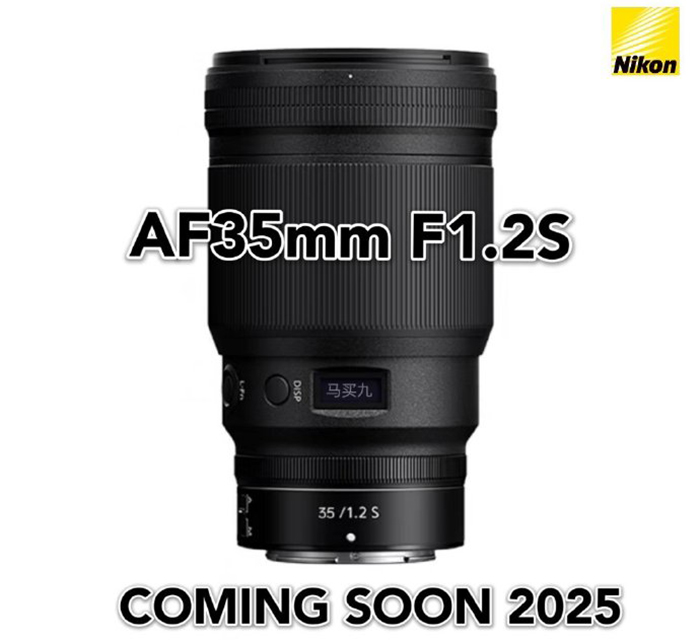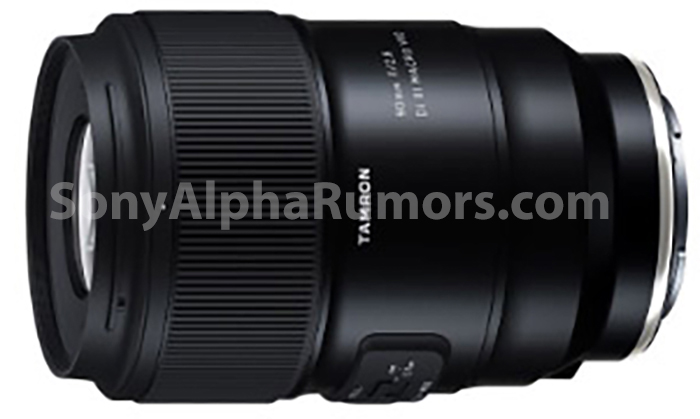Nikon Nikkor Z 35mm f/1.2 S lens will be announced tomorrow

This image is a mockup
The new Nikon Nikkor Z 35mm f/1.2 S lens will be announced tomorrow (Feb 5). Price is about $3,000 and filter size will be 82mm.
Source: Weibo

This image is a mockup
The new Nikon Nikkor Z 35mm f/1.2 S lens will be announced tomorrow (Feb 5). Price is about $3,000 and filter size will be 82mm.
Source: Weibo
A trusted source just shared this info:
The announcement should happen within few weeks!
I got a tip from a trusted source that a new Nikon 35mm f/1.2 Z might be announced in a couple of weeks. This lens was rumored (by others) to be coming already last year but those rumors were plain wrong. But finally it’s coming 🙂
The sources did yet not get any details about other products so it seems this is maybe all we will get at the CP+ show this year!
P.S.: The lens was shows on the official Nikon lens roadmap a couple of years ago:


Based on a mix of rumors and good guess this is what the Nikon Z9II could be when announced in 2025:
Nikon’s Future Z9II: What to Expect from the Next Flagship Mirrorless Camera
Nikon has been making waves in the professional camera market since the release of the Z9, its groundbreaking flagship mirrorless camera. Combining cutting-edge technology, robust build quality, and professional-grade features, the Z9 set a new benchmark for the industry. However, as competitors continue to push boundaries, all eyes are on Nikon’s next big release—the Nikon Z9II. Here’s what we might expect from the successor to this flagship model, based on market trends, Nikon’s strategy, and user demands.
Enhanced Sensor Technology
One of the standout features of the Z9 was its 45.7MP stacked CMOS sensor, offering exceptional speed and image quality. For the Z9II, Nikon may aim to improve resolution without sacrificing speed. Industry speculation suggests we could see a new sensor with up to 61MP, rivaling Sony’s high-resolution A7R series while maintaining the speed and efficiency needed for sports and wildlife photography.
Alternatively, Nikon might focus on improved dynamic range and low-light performance through advanced sensor technology, such as backside illumination (BSI) or even global shutter implementation, which could eliminate rolling shutter issues entirely.
Next-Generation EXPEED Processor
The Z9’s EXPEED 7 processor was a game-changer, enabling 8K video recording, impressive autofocus performance, and real-time processing. The Z9II is likely to feature the next-generation EXPEED 8 processor, bringing faster data handling, enhanced burst rates, and even more advanced computational photography features. This upgrade could also improve energy efficiency, potentially extending battery life.
Autofocus Refinements
Nikon’s autofocus system in the Z9 received widespread praise for its speed and accuracy, particularly in tracking moving subjects. For the Z9II, Nikon may introduce:
• Expanded subject detection capabilities, such as enhanced animal eye detection or tracking for smaller, fast-moving objects.
• Improved AI-driven autofocus algorithms, ensuring near-flawless performance in complex shooting scenarios.
• More focus points, potentially covering the entire frame, for unparalleled compositional freedom.
Video Capabilities
The Z9 made a bold statement with its 8K 60p RAW video recording capabilities. The Z9II could take this even further by:
• Offering 8K at higher frame rates (e.g., 120p), providing smoother footage for cinematic production.
• Introducing internal 10-bit 4K 240p recording for slow-motion enthusiasts.
• Improved heat dissipation, allowing extended recording times for professional videographers.
Additionally, Nikon may explore real-time LUT application and improved codec options like ProRes RAW or even 12-bit N-RAW for unmatched post-production flexibility.
Design and Build
The Z9’s body was robust, weather-sealed, and designed for professional use. The Z9II is expected to retain this durability while possibly:
• Reducing weight slightly through the use of advanced materials like magnesium-lithium alloys.
• Enhancing ergonomics, particularly for prolonged handheld use.
• Adding a tiltable and fully articulating screen for greater versatility in shooting angles.
Connectivity and Storage
The Z9 set a high standard with its dual CFexpress Type B card slots and extensive connectivity options. For the Z9II, Nikon could:
• Incorporate dual CFexpress Type B/SD hybrid slots, appealing to a broader range of users.
• Expand wireless capabilities with 5G connectivity for seamless on-the-go uploads and remote shooting.
• Introduce advanced tethering options for studio photographers.
Battery Life and Power Options
With the Z9II potentially consuming more power due to enhanced features, Nikon might include:
• Improved battery efficiency, possibly through a more energy-efficient processor.
• Support for USB-C Power Delivery charging, enabling faster and more versatile charging options.
Price and Release Date
Given Nikon’s typical release cycle and the increasing competition from Sony’s A1II and Canon R1r (High resolution model), the Z9II might arrive in early 2025. Pricing is expected to remain in the premium range, likely around $5,500–$6,000, positioning it as a tool for professional photographers and videographers.
Conclusion
The Nikon Z9II has the potential to build on the immense success of the Z9 by introducing significant upgrades in resolution, speed, and functionality. With competitors like Sony and Canon constantly pushing the envelope, Nikon must continue innovating to solidify its position in the professional market. The Z9II could very well be a game-changer, offering professionals the ultimate tool to bring their creative visions to life.

As the camera industry continues to evolve, Nikon finds itself at a pivotal moment. The transition to mirrorless cameras has been largely successful, with the Z-mount gaining traction among professionals and enthusiasts alike. However, to maintain momentum and excitement, Nikon will need to expand its lineup strategically in 2025. Here’s a look at what gear Nikon could—and perhaps should—announce to captivate photographers in the coming year.
Building on the success of the Z8 and Z9, Nikon could introduce updated versions of these flagship cameras. Expected improvements might include:
Nikon Z7 II is due for updates. The next generation could include:
Following the likely success of the retro-styled Zf, Nikon could release a second iteration in 2025. This model might feature:
To appeal to wildlife and sports photographers seeking lighter gear, Nikon could introduce a high-performance APS-C mirrorless camera:
An affordable entry-level full-frame camera could help Nikon attract new users:
Nikon could expand its lineup of Z-mount super-telephoto primes:
To attract budget-conscious photographers, Nikon could introduce:
The Z-mount system could benefit from compact primes for street and travel photographers:
Nikon could release more professional-grade zooms with faster apertures:
Expanding the macro lineup could include:
Battery grips with additional controls, improved ergonomics, and hot-swappable batteries would enhance usability for professionals.
A high-resolution EVF with built-in AI features, such as subject highlighting and augmented reality overlays, could revolutionize the shooting experience.
Modules that add functionality—such as XLR inputs for audio, larger displays for video monitoring, or advanced flash control—could cater to hybrid shooters.
New, faster memory cards compatible with CFexpress slots could improve workflow for high-resolution video and continuous shooting.
Nikon may also venture into innovative technologies, such as:
Nikon’s announcements in 2025 could redefine its market position. By balancing updates to its professional-grade cameras with fresh offerings for enthusiasts and newcomers, Nikon has the potential to excite and expand its user base. With cutting-edge lenses, innovative features, and strategic pricing, the future of Nikon’s Z-mount system looks brighter than ever. The key will be to stay ahead of the competition while catering to the diverse needs of modern photographers and videographers.

On September 26 at 6am London time Tamron will launch their next new Full Frame lens. It’s the 90mm F2.8 Di III VXD 1:1 MACRO.
Press text:
TAMRON 90mm F2.8 Di III VXD 1:1 MACRO for SONY E-MOUNT & NIKON Z MOUNT (Model F072)
TAMRON’s Legendary 90mm Macro is Reborn for Mirrorless
TAMRON’s new 90mm F2.8 MACRO for full-frame mirrorless offers unparalleled sharpness from center to edge and a velvety bokeh effect. TAMRON introduces its first 12-blade circular aperture, ensuring perfectly circular bokeh and minimal vignetting especially in the macro range. The 12-blade design creates 12 rays for stunning starburst effects when stopped down, making it ideal for dramatic images with point light sources. This compact mid-telephoto macro is just 126.5mm (5″) long and weighs 630g (22.2oz.), has a maximum diameter of 079.2mm. It fits comfortably in the palm making it easy to hold for long periods of time. The lens is equipped with a focus limiter switch that can restrict the AF focus range, enabling faster focusing during AF shooting. This feature also helps prevent the lens from searching focus in full range when losing focus during close-range AF photography. The rotational torque of the focus ring has been carefully calibrated to assist with precise Manual Focus operation. SonyAlphaRumors
This moderate torque makes fine-tuning the focus more exact and ensures that the results are accurate. The new hood design with a sliding window for easy filter use lets photographers rotate filters without removing the hood. The 90mm F2.8 MACRO is compatible with the dedicated TAMRON Lens Utility software. It lets users change lens settings, assign camera functions and update firmware when necessary. In addition, the mobile version is especially useful for macro photography where a tripod is often used. Users may customize functions for various still photography and videography shooting styles. This lens excels in macro, landscape, and portrait photography, offering unique photographic expressions across genres.
Key Features
Specifications of the 90mm Di Ill
*Length and weight are for Sony E-Mount
Compared with the Sony the Tamron can focus 5cm closer (23cm vs 28cm), has 12 blades instead of 9. I suspect price will be lower too.
–
Thanks to the source for sending me this!
